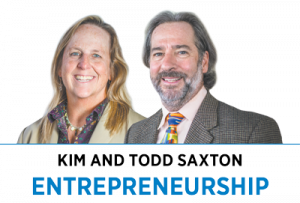Subscriber Benefit
As a subscriber you can listen to articles at work, in the car, or while you work out. Subscribe Now Over the past few months, we’ve participated in several conferences celebrating the spirit of entrepreneurship and innovation. These sessions have included the inaugural Rally (congrats and well done!) and the Innovation Showcase (always a great event).
Over the past few months, we’ve participated in several conferences celebrating the spirit of entrepreneurship and innovation. These sessions have included the inaugural Rally (congrats and well done!) and the Innovation Showcase (always a great event).
At an abstract level, being an entrepreneur sounds super exciting. Who wouldn’t want to start something that solves a problem that makes people’s lives better, while also creating wealth and jobs for founders, investors and others? At the same time, several sessions at the above events reminded us of the very concrete challenges that hold many potential startups back, particularly from under-resourced and underrepresented founders. In many cases the entrepreneur must navigate a lack of knowledge on parallel paths of the legal and tactical aspects of getting a business going, as well as the market uncertainty of finding the right product or service for the right customer(s). It is kind of like playing a new sport while learning the rules on the fly or building a plane while you are flying it. And all this while facing a lack of resources.
While these are complex challenges, we will attempt to disentangle them, and provide ideas of how to overcome some of them.
Working through the mechanics of setting up and running a business. Setting up a business is much harder than people realize. There are very subjective steps like coming up with a name you like that will resonate with customers (and getting the website). But there are also important aspects like how to choose the right legal structure for your business and when to get insurance. This requires an attorney or expert well-versed in startups because different legal structures have different advantages if you ever want to seek outside funding. Once the business has a name and legal structure, there are still bureaucratic steps that include registering with the state and possibly getting a sales tax ID. All of these steps, and others, require knowing that the step exists, being able to find out where to access and file the paperwork, actually filing the paperwork out and submitting it, often with an application fee.
Understanding the new venture process. Finding product/market fit is a process that can unfold over several or many more years. At the start, the idea is really just a hypothesis, an idea of what the founder thinks will solve a problem for someone. Entrepreneurs need to be experimenters who develop a plan to try one approach but be willing to pivot when things are not working out smoothly. That means being flexible early on as you are figuring things out, and not overinvesting too early. Part of this process requires talking to potential customers. What is the problem from their perspective? What “job” is your offering doing for them, and how do they measure outcomes they will view as success?
Access to funding and resources. In addition to a lack of knowledge and experience, especially for the first-time entrepreneur, securing early funding can be quite challenging. For some startups, the first round of fundraising is called a “Friends and Family Round.” The theory is that you ask everyone you know for small investments to help you get started. This is great if your friends, families and neighbors have some disposable money in their bank accounts. But what if you have few friends or family members and the ones you do are struggling financially? As one session at Rally noted, the existing race-based wealth gap, for example, means some would-be entrepreneurs do not have friends and family with resources. These entrepreneurs have a first funding phase called the “Visa Round.” Once they max out their (and their partner’s) credit cards, they have to find more funds simply to keep the lights on.
So how can you find resources to help address the lack of knowledge and funding? For mechanics, the Small Business Administration offers support. We were excited to hear about the efforts of Right to Start in establishing policies that make it easier for anyone to start a business. The Indiana Economic Development Corp. has a number of initiatives to help including the new ConnectIND website. Organizations such as SCORE, chambers of commerce, and others also help address these barriers, and Kelley and other schools have programs teaming business students with entrepreneurs and small businesses.
Knowledge gaps are also being addressed by community groups that support entrepreneurs such as Powderkeg, The Startup Ladies, Be Nimble Foundation, experienced entrepreneurs who act as mentors, and accelerators like TechStars, Gener8tor, GrowthX, and others. We apologize as we are sure we are missing many other good organizations.
For funding, pitch competitions offer both seed funding and some scale funding.
One of the great things about entrepreneurship is that it is not a zero-sum game. One startup’s success does not come from the failure of another. As we encounter entrepreneurs who are struggling with some of these barriers, take ownership of helping advocate for them, and lead them to some of the resources we mention here.•
__________
Kim Saxton is a clinical professor of marketing at IU Kelley School of Business, Indianapolis. Todd Saxton is an associate professor of strategy and entrepreneurship at IU Kelley School of Business, Indianapolis. They are co-authors of “The Titanic Effect: Successfully Navigating the Uncertainties that Sink Most Startups.”
Please enable JavaScript to view this content.
